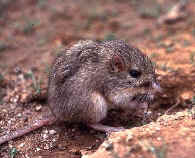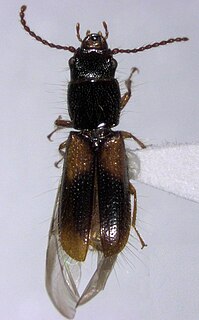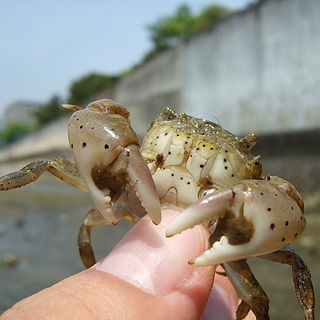Related Research Articles

Brandt's cormorant is a strictly marine bird of the cormorant family of seabirds that inhabits the Pacific coast of North America. It ranges, in the summer, from Alaska to the Gulf of California, but the population north of Vancouver Island migrates south during the winter. Its specific name, penicillatus is Latin for a painter's brush, in reference to white plumes on its neck and back during the early breeding season. The common name honors the German naturalist Johann Friedrich von Brandt of the Academy of Sciences at St. Petersburg, who described the species from specimens collected on expeditions to the Pacific during the early 19th century.

The white-tipped tufted-tailed rat is a rodent endemic to Madagascar. It is known from only two specimens, one collected from Ampitambe forest in 1895 or 1896 and the second in 2000. It is listed by the International Union for Conservation of Nature (IUCN) as an endangered species due to habitat loss.

The desert pocket mouse is a North American species of heteromyid rodent found in the southwestern United States and Mexico. True to its common name, the medium-sized desert pocket mouse prefers sandy, sparsely vegetated desert environments.

The brush-tailed rabbit rat is a species of rodent in the family Muridae. It is found in Australia and Papua New Guinea.

Hemigrapsus takanoi, the brush-clawed shore crab or Asian shore crab, is a small crab of the family Varunidae that lives on rocky shores surrounding the Pacific Ocean, and which is invasive along the European coastlines. This crab is omnivorous and eats small fish, invertebrates and algae.

Chaetosomatidae is a small family of beetles, in the suborder Polyphaga.
The Chihuahuan pocket mouse is a species of heteromyid rodent found in the southwestern United States and Mexico. It was formerly considered a subspecies of the desert pocket mouse, but was determined to be a distinct species in 1996, following analysis of its mitochondrial DNA.

Hemigrapsus is a genus of varunid crabs comprising thirteen species native almost exclusively in the Pacific Ocean, but two have been introduced to the North Atlantic region.

Pseudodynerus is a small Neotropical genus of potter wasps currently containing 16 species.
The Hemioniscidae are a family of marine isopod crustaceans in the suborder Cymothoida. The original description was made by Bonnier in 1900. Members of this family are parasitic on cirripede barnacles.

Hemigrapsus penicillatus is a species of crab. The native range of Hemigrapsus penicillatus extends from the Russian Far East along the coasts of Japan, China, Taiwan and Korea, as far south-west as Hong Kong. Although the species was reported from Hawaii in 1903, this is likely to have been an error; there are no recent records of the species in the central Pacific. Reports of H. penicillatus on the coasts of Europe refer to a related species, H. takanoi, which was only distinguished from H. penicillatus in 2005, several years after its discovery in Europe. Hemigrapsus penicillatus lives in the intertidal zone on stony or muddy shores.

Panulirus penicillatus is a species of spiny lobster that lives on shallow rocky and coral reefs in the tropical Indo-Pacific region. Common names for this spiny lobster include variegated crayfish, tufted spiny lobster, spiny lobster, Socorro spiny lobster, red lobster, pronghorn spiny lobster, golden rock lobster, double spined rock lobster and coral cray. It has a very wide range and the International Union for Conservation of Nature has assessed its conservation status as being of "least concern".

Scolopterus penicillatus, also known as the black spined weevil, is an endemic beetle of New Zealand. The beetle is present throughout New Zealand and can be discovered by beating native flowering plants in the summer months. In appearance it is a shining black colour with a purplish tinge and looks very similar to its close relative Scolopterus tetracanthus. S. penicillatus can be distinguished from S. tetracanthus as the spines on the shoulders of the former are much less pointed. Adult black spined weevils have been collected from Hedychium gardnerianum and caught in the flowers of Helichrysum lanceolatum. The larvae of S. penicillatus are known to develop in the recently dead bark of the various species of Pseudopanax.

Chaetosoma scaritides is a species of beetles in the family Chaetosomatidae. It is the type species of its genus.
Malgassochaetus is a genus of beetles in the family Chaetosomatidae.
Malgassochaetus crowsoni is a species of beetles in the family Chaetosomatidae. It is found in Madagascar.
Malgassochaetus descarpentriesi is a species of beetles in the family Chaetosomatidae. It is found in Madagascar.
Malgassochaetus viettei is a species of beetles in the family Chaetosomatidae. It is found in Madagascar.
Malgassochaetus sogai is a species of beetles in the family Chaetosomatidae. It is found in Madagascar.

Cyanothamnus penicillatus is a plant in the citrus family, Rutaceae and is endemic to the south-west of Western Australia. It is a low, spreading shrub with pinnate leaves and white flowers with four petals and eight stamens.
References
- ↑ Menier, J.J. & Ekis, G. 1982. Les Chaetosomatidae malgaches. 2. Description d'un genre nouveau et de quatre espèces nouvelles. (Coleoptera, Cleroidea). Annales de la Société Entomologique de France (N.S.) 18(3): 343–348
-
 Data related to Malgassochaetus penicillatus at Wikispecies
Data related to Malgassochaetus penicillatus at Wikispecies